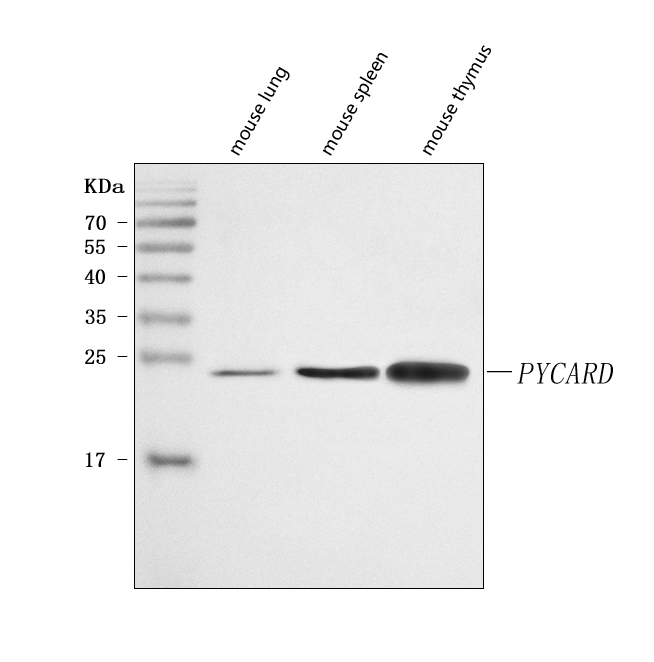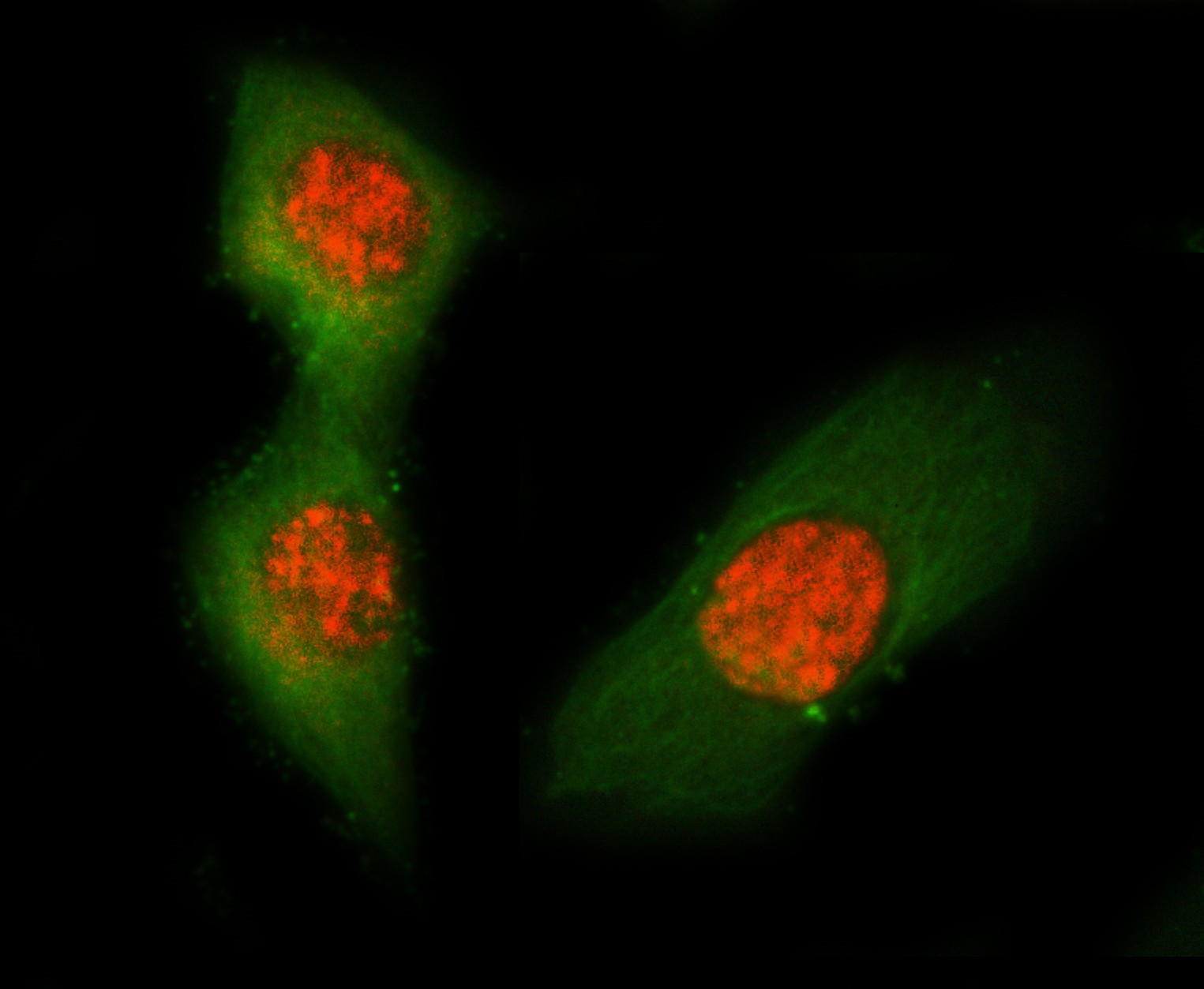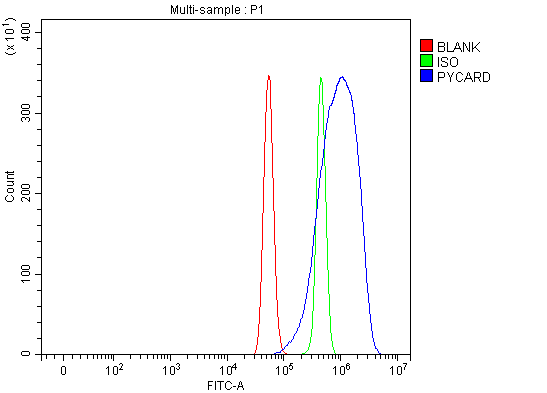| Western blot (WB): | 1:500-2000 |
| Immunocytochemistry/Immunofluorescence (ICC/IF): | 1:50-400 |
| Flow Cytometry (Fixed): | 1:50-200 |
| Enzyme linked immunosorbent assay (ELISA): | 1:100-1000 |

Western blot analysis of anti-ASC/TMS1/Pycard antibody (A00362-5). The sample well of each lane was loaded with 30 ug of sample under reducing conditions.
Lane 1: mouse lung tissue lysates,
Lane 2: mouse spleen tissue lysates,
Lane 3: mouse thymus tissue lysates.
After electrophoresis, proteins were transferred to a membrane. Then the membrane was incubated with rabbit anti-ASC/TMS1/Pycard antigen affinity purified polyclonal antibody (A00362-5) and probed with a goat anti-rabbit IgG-HRP secondary antibody (Catalog # BA1054). The signal is developed using ECL Plus Western Blotting Substrate (Catalog # AR1197). A specific band was detected for ASC/TMS1/Pycard at approximately 22 kDa. The expected band size for ASC/TMS1/Pycard is at 22 kDa.

IF analysis of ASC/TMS1/Pycard using anti-ASC/TMS1/Pycard antibody (A00362-5) and anti-Tubulin alpha antibody (M03989-3).
ASC/TMS1/Pycard was detected in an immunocytochemical section of RM1 cells. Cy3-Conjugated Anti-rabbit IgG Secondary Antibody (Red) (Catalog # BA1032) and Dylight488-conjugated Anti-mouse IgG Secondary Antibody (Green) (Catalog # BA1126) were used as secondary antibody.

Flow Cytometry analysis of RAW264.7 cells using anti-ASC/TMS1/Pycard antibody (A00362-5).
Overlay histogram showing RAW264.7 cells stained with A00362-5 (Blue line). To facilitate intracellular staining, cells were fixed with 4% paraformaldehyde and permeabilized with permeabilization buffer. The cells were blocked with 10% normal goat serum. And then incubated with rabbit anti-ASC/TMS1/Pycard Antibody (A00362-5, 1:100). DyLight®488 conjugated goat anti-rabbit IgG (BA1127, 1:100) was used as secondary antibody. Isotype control antibody (Green line) was rabbit IgG (Catalog # BA1045) (1:100) used under the same conditions. Unlabelled sample (Red line) was also used as a control.

Western blot analysis of anti-ASC/TMS1/Pycard antibody (A00362-5). The sample well of each lane was loaded with 30 ug of sample under reducing conditions.
Lane 1: mouse lung tissue lysates,
Lane 2: mouse spleen tissue lysates,
Lane 3: mouse thymus tissue lysates.
After electrophoresis, proteins were transferred to a membrane. Then the membrane was incubated with rabbit anti-ASC/TMS1/Pycard antigen affinity purified polyclonal antibody (A00362-5) and probed with a goat anti-rabbit IgG-HRP secondary antibody (Catalog # BA1054). The signal is developed using ECL Plus Western Blotting Substrate (Catalog # AR1197). A specific band was detected for ASC/TMS1/Pycard at approximately 22 kDa. The expected band size for ASC/TMS1/Pycard is at 22 kDa.

IF analysis of ASC/TMS1/Pycard using anti-ASC/TMS1/Pycard antibody (A00362-5) and anti-Tubulin alpha antibody (M03989-3).
ASC/TMS1/Pycard was detected in an immunocytochemical section of RM1 cells. Cy3-Conjugated Anti-rabbit IgG Secondary Antibody (Red) (Catalog # BA1032) and Dylight488-conjugated Anti-mouse IgG Secondary Antibody (Green) (Catalog # BA1126) were used as secondary antibody.

Flow Cytometry analysis of RAW264.7 cells using anti-ASC/TMS1/Pycard antibody (A00362-5).
Overlay histogram showing RAW264.7 cells stained with A00362-5 (Blue line). To facilitate intracellular staining, cells were fixed with 4% paraformaldehyde and permeabilized with permeabilization buffer. The cells were blocked with 10% normal goat serum. And then incubated with rabbit anti-ASC/TMS1/Pycard Antibody (A00362-5, 1:100). DyLight®488 conjugated goat anti-rabbit IgG (BA1127, 1:100) was used as secondary antibody. Isotype control antibody (Green line) was rabbit IgG (Catalog # BA1045) (1:100) used under the same conditions. Unlabelled sample (Red line) was also used as a control.




